The story of the old, tall ones: Sequoia.
And climbing them…
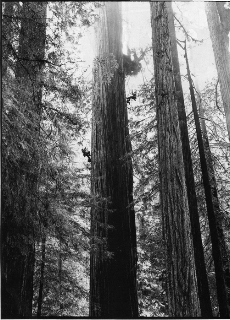
Learning comes in differing ways.
The conference for Technology, Entertainment & Design: TED, is one of them. I’m a member of the TED community. You go there, literally, to be a part of that sharing. And an extraordinary sharing it is.
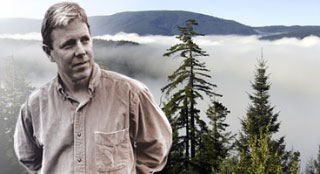
Through TED, I reconnected with the author Richard Preston. I’d first encountered him with his “Hot Zone” — an adventuresome read into the wildfire disease spread — the ranging (and raging) opening of the Ebola virus. (I met Laurie Garrett there at TED as well, speaking of virological catastrophe, “The Coming Plague” Cheery topics, for sure — but good to be conscious…)
But Richard is an explorer — and a lover of trees, authoring “Wild Trees”; he’s a climber of them, as well. A climber (and lover) of really big trees. Like 300+ foot trees.
Sequoia Sempervirens.
An ancient lineage, the last survivors are the Coast Redwood and California Redwood (it is one of three species of trees known as redwoods, but “redwood” normally refers to this species). An evergreen, long-lived, monoecious tree spanning up to 2,200 life years, including the tallest trees in the world, reaching up to 115.5 m (379.1 ft) in height, spreading 8 m (26 ft) diameter at breast height.
Now looking up at that tree, the one shown above, you can see that climbing wouldn’t be an easy option — it’s more engineering and alpinist than conventional tree climbing — which is more of what I’ve done. All I’ve ever done, actually, when it comes to climbing trees.
The name “sequoia” is sometimes used as a general term for the subfamily Sequoioideae in which this genus is classified, together with Sequoiadendron (Giant Sequoia) and Metasequoia (Dawn Redwood); as a common name, it usually refers to Sequoiadendron.
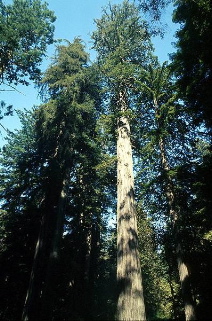
Richard’s written a book on his explorations of the tree-climbing in “Wild Trees” And there’s a great deal to examine in the beginnings of that idea of being in, being above, being in the heart of the tree space. What Preston brings to light is that there is whole new and unstudied world up there — the canopies at the top of these groves, the Coastal Redwood forests, harboring an amazing ecosystem of now only recently discovered organisms and plant life. And, only in the last decade, has anyone even been up there to explore this realm.
To the emerging study, Terry Dunn, Smithsonian writer, notes “in some ways, forest canopies, whether tropical or temperate, have been as mysterious as the ocean depths were before the invention of submarines and scuba equipment.” Each poses an abundance of new life, coupled with adventure — regardless of the geographic locale. “The canopy of a tropical rainforest, in particular, presents an obstacle course of challenges to curious visitors. It’s not unusual to encounter stinging insects, venomous reptiles, thorny plants, razor-edged leaves, lightning, sudden winds, surprisingly cold rain, and unbearable heat, perhaps all in the same day.” The same can be said of the hazards of temperate forest canopies which “may not be as abundant, but all treetop adventurers, or arbonauts, risk falling and unexpectedly finding themselves on the forest floor.”
If there’s a scholar of the redwood realm, it’s Professor Steve Sillett, Humboldt, California. He’s the world authority on this grouping of trees, based on decades of work, in the Pacific Northwest, as well as northern California. Besides being a researcher, he’s an advocate, as Preston notes, the forest canopies of the earth are realms of unfathomed nature, and they are largely a mystery. They are also disappearing – they are being logged off rapidly, burned away, turned into fragments and patches and they are perhaps being altered by changes in the earth’s climate caused by human activities.
Sillett said, “We want to try to understand the basic biology of the redwood canopy, because it will give us a blueprint for how things should work in an old-growth redwood forest.” Not only are these trees are the elders of the arboreal world, they alter where they live. “Redwoods are able to reshape the local climate and environment in which they live. They change the chemical nature of the soil, and they assume control of vital resources in the forest, particularly sunlight and water.
“We’re trying to get a feel for how much water is stored in the canopy – in the trees, in their foliage, in the canopy soil, and in other plants that live in the canopy,” Sillett said. “There’s a lot of water up here. These trees are controlling the movement of the water in this forest. How do they do that? What will happen to these forests as the climate changes with global warming? The way the world is going, our work in the canopy could be just a task of documenting something before it winks out.”
As the first real voyager of the canopy realm, Steve Sillett began to encounter things that no one had imagined. Among biologists at the time – only eight years ago – the standing theory was that the redwood canopy was a so-called “redwood desert” that contained nothing more than the branches of redwood trees. Sillett had discovered a lost world above Northern California.
According to Preston’s interviews, Sillett found that the canopy is packed with epiphytes, plants that grow on other plants; these commonly occur on trees in tropical rain forests, but nobody really expected to find them abundantly flourishing in Northern California.
“There are hanging gardens of ferns, in masses, that Sillett calls fern mats. These dense masses can weigh tons when they are saturated with rainwater; they are the heaviest masses of epiphytes which have been found in any forest canopy on earth. Layers of earth, called canopy soil, accumulate over the centuries on wide limbs and in the tree’s crotches – in places where trunks spring from trunks – and support a variety of animal and plant life. In the crown of a giant redwood named Fangorn, Sillett found a layer of canopy soil that is three feet deep.” Other discoveries emerged — at the crown of “Laurelin, or the Tree of the Sun, which is three hundred and sixty-eight feet tall and still growing, Sillett discovered a huge, sheared-off trunk with a rotted, damp center. Masses of shrubs are growing out of the wet rot, sending their roots down into Laurelin.”
Sillett’s teams have found small, pink earthworms of an unidentified species in the beds of soil in the redwoods. A Humboldt colleague of Sillett’s named Michael A. Camann has collected aquatic crustaceans called copepods living in the fern mats. Sillett said, “They commonly dwell in the gravel in streams around here.” There’s no explanation as to how they got “up there”. Another student of Sillett team investigations, James C. Spickler, has focused on “wandering salamanders” in the redwood canopy. They are brown and gold, nocturnally feeding on insects. Spickler discovered that the salamanders were breeding in the redwood canopy, suggesting that they never visit the ground – a population of salamanders living its entire life cycle in the redwood canopy.
The crowns, or uppermost levels of the old trees, are festooned with thickets of huckleberry bushes. Climbing the trees, Sillett and his colleagues stop and rest inside huckleberry thickets, hundreds of feet above the ground, and gorge on the berries. Other canopy saprophytic relationships are currant, elderberry and salmonberry bushes, which occasionally put out fruit, too. There are other colonists — California bay laurel trees, western hemlocks, Douglas firs, and tan oaks. Sillett even spotted an eight-foot Sitka spruce growing on the limb of a giant redwood.
So how did getting there even happen? Climbing the trees is like climbing a mountain. But different, according to Wes Jones’ site: “Rock climbers move upward over a vertical surface of stone by using their hands and feet to obtain friction and support. They are not suspended from taut ropes (except sometimes in the type of rock climbing called aid climbing). A rock climber advances upward while a safety rope, held by a person called a belayer, trails loosely below him. The rope is there in case the rock climber loses his grip on the stone and falls. In tree climbing, the rope is used as the main tool for gaining height and for moving around. The bark of a tree is crumbly and soft, and a climber can’t get any kind of secure grip on it with his hands and feet. The branches of a tree can snap off.
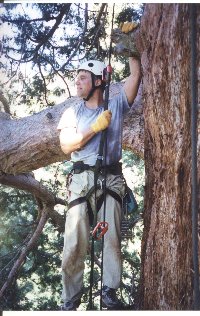
Image from Dancing With Trees.
The method by which Steve Sillett and his colleagues climb redwoods is known as a modified arborist-style climbing technique using a special soft, thick, strong rope. When the rope is passed over an anchor point, it is formed into a long loop or noose, which is tied with a sliding knot called the Blake’s hitch. The Blake’s hitch was invented in 1990 by a tree surgeon in California named Jason Blake. He popularized it among arborists. It looks a little bit like a hangman’s knot, though it functions in a different way. It is a friction knot – it can grip securely on a length of rope, or it can slide on the rope, depending on how the knot is manipulated.”
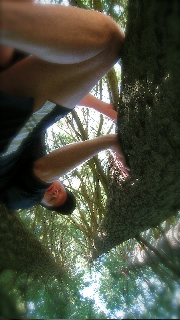
Me? I simply climb. Look, wonder, and revel in trees.
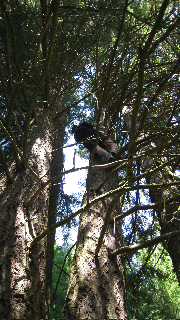
Tim Girvin | Chicago
References and more to explore:
Arborist M.D. Vaden’s tree site (the most comprehensive nexus):
http://www.mdvaden.com/grove_of_titans.shtml
Putting out a fire in a sequoiadendron:
http://www.fs.fed.us/treeclimbing/news/eagle-creek-fire/
Engineering an ascent:
http://vids.myspace.com/index.cfm?fuseaction=vids.individual&videoid=31025152
Content from Richard Preston, The New Yorker:
http://www.wesjones.com/climbing1.htm
Richard Preston’s website:
http://www.richardpreston.net/books/wt.html
Arboreal canopy exploration:
http://nationalzoo.si.edu/publications/zoogoer/2004/5/treetops.cfm
The Giant Sequoia — Forest Masterpieces:
http://www.nps.gov/archive/seki/bigtrees.htm
National Park Management
http://www.nps.gov/archive/seki/fire/obj_eco.htm
National Geographic Summits (1&2)
http://www.youtube.com/watch?v=F3j8q6x-gE0&feature=related
http://www.youtube.com/watch?v=6zWbjqAON34&feature=related
Logging:
http://www.youtube.com/watch?v=A_UqhcByRdY&feature=related
References: the tallest trees in the world:
http://hypertextbook.com/facts/2001/OlgaVapnyar.shtml
The oldest tree in the world:
http://www.telegraph.co.uk/earth/main.jhtml?view=DETAILS&grid=A1YourView&xml=/earth/2008/04/17/eatree117.xml
I’m just testing to see if this actually is functioning — and frankly wishing that I could be outside now, climbing trees.
tsg | memorial day